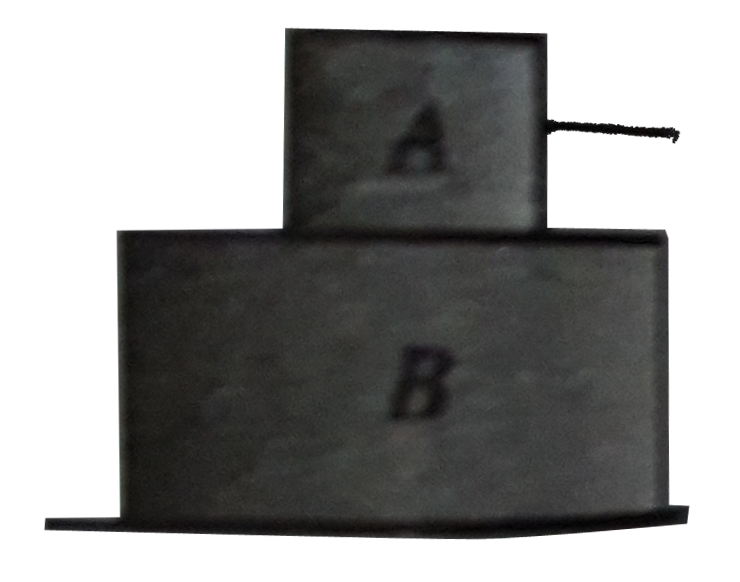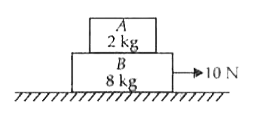A block of mass 4 kg is kept on a smooth horizontal table surface Fig. Another body of mass 1 kg is placed over one end of the block. Length of the block is 150 cm. Coefficient of friction between the block and the body is 0.1. If a force of 106 dyn is applied on the block when does the body fall off the block?

Let the force applied on the block, so that the smaller body begins to slide be F (=106 dyn = 10 N). Let the mass of the block be M and that of the smaller body be m. Hence, the friction f, acting in the direction of F and opposing the slipping of the smaller body is equal to μ mg.
Let the acceleration of masses M and m be a1 and a2 (both taken in the direction of F ) respectively, with respect to the table.
Hence, for the 4 kg block,
F-f = Ma1
and for the 1 kg body, f = ma2
From equations (1) and (2), we get the acceleration of the body with respect to the block,
a2−a1=fm−F−fM
=μmgm−F−μmgM=μg(m+M)−FM
Substituting the values,
a2−a1=0.1×9.8(1+4)−104
=-5.14=−1.275m.s−2
As , s=12at2,
t=√2sa=√2×1.51.275 [s=150 cm=1.5 m and a = 1.275 m.s−2]
= 1.53 s
Topper's Solved these Questions
- FRICTION Book:CHHAYA PUBLICATIONChapter:FRICTION Exercise:Section Related Questions
Explore 9 Videos
- FRICTION Book:CHHAYA PUBLICATIONChapter:FRICTION Exercise:HIGHER ORDER THINKING SKILL ( HOTS ) QUESTIONS
Explore 14 Videos
- FIRST AND SECOND LAW OF THERMODYNAMICSBook:CHHAYA PUBLICATIONChapter:FIRST AND SECOND LAW OF THERMODYNAMICSExercise:CBSE SCANNER
Explore 18 Videos
- HYDROSTATICSBook:CHHAYA PUBLICATIONChapter:HYDROSTATICSExercise:CBSE SCANNER
Explore 1 Video
Similar Questions
What is friction? What is the origin of friction?
View SolutionWhy should one take short footsteps while walking on ice ( or oily surface ) ?
View SolutionWrite the second law of thermodynamics.
View SolutionUsing Pascal's law, explain with a neat figure, the working of a hydraulic lift. Mention any one situation from your daily life where hydrostatic paradox is useful.
View SolutionTwo blocks of masses 1 kg and 2 kg are placed in contact on a smooth horizontal surface as shown in fig. A horizontal force of 6N is applied d(a) on a 1-kg block. Find the force of interaction of the blocks. .
View SolutionA block A of mass 2kg is placed over smooth block B of mass 4kg which is placed over a smooth horizontal floor The coefficient of friction between A and B is 0.4 when a horizontal forces of magnitude 10N is applied on A the acceleration of block of A and B are

View SolutionMass of upper block and lower block kept over the table is 2 kg and 1 kg respectively and coefficient of friction between the blocks is 0.1. Table surface is smooth. The maximum mass M for which all the three blocks move with same acceleration is (g = 10 m/s2) -

View Solution4 kg द्रव्यमान वाले एक गुटके पर 2 kg द्रव्यमान वाला दूसरा गुटका रखा हुआ है तथा दोनों एक चिकने क्षैतिज टेबुल पर रखे हुए है|गुटकों के बीच घर्षण गुणांक 0.20 है| दोनों गुटकों का त्वरण ज्ञात कीजिए यदि 12 N का एक क्षैतिज बल (a ) ऊपर वाले गुटके पर (b ) निचे वाले गुटके पर लगाया जाता है| (g=10m/s2)
View SolutionA block of mass 0.1 kg is kept pressed against a wall by applying a force of 5 N horizontally on the block. Coefficient of friction between the block and the wall is 0.5. Friction acting on the block is.
View SolutionA block of mass M is kept on a frictionless horizontal table. A body of mass m is kept on the block. If a force F, Parallel to the table top is applied on the block, the body on the block tends to slide backwards. What is the coefficient of static friction between the block and the body?
View SolutionBlock A of mass 2 kg is placed over block B of mass 8 kg .The combination is placed over a rough horizonatal surface .Cofficient of friction between B and the floor is 0.5 .Coefficient of friction berween A and B is 0.4 .A horizontal force of 10 N is applied on block B .The force of friction between A and B is
(g=10 ms−2)

View SolutionOn a smooth horizontal surface a block A of mass 10kg is kept. On this block a second block B of mass 5kg is kept. The coefficient of friction between the two blocks is 0.4 .A horizontal force of 30N is applied on the lower block as shown. The force of friction between the blocks is
View SolutionA 3 kg block is placed over a 10 kg block and both are placed on a smooth horizontal surface. The coefficient of friction between the blocks is 0.2. If a horizontal force of 20 N is applied to 3 kg block, accelerations of the two blocks in ms^(-2) are (g = 10 ms^(-2))
View SolutionA 2kg block is placed over a 4kg block and both are placed on a smooth horizontal surface. The coefficient of friction between the blocks is 0.20. The acceleration of the two blocks if a horizontal force of 12N is applied to the lower block is (g=10ms−2)
View Solutionforce F = 100 N is applied horizontally on a block of mass 4 kg. Which is in contact with a wall. Such that it does not fall. The coefficient of friction between the block and the wall is
View SolutionA 2kg block is placed over a 4kg block and both are placed on a smooth horizontal surface. The coefficient of friction between the blocks is 0.20. The acceleration of the two blocks if a horizontal force of 12N is applied to the lower block is
View Solution

